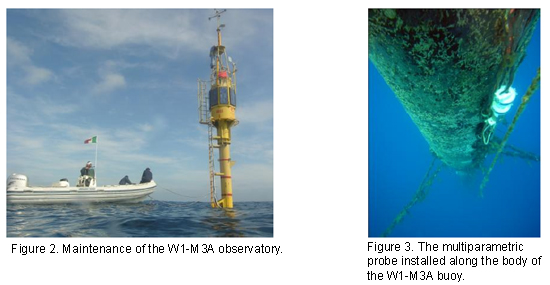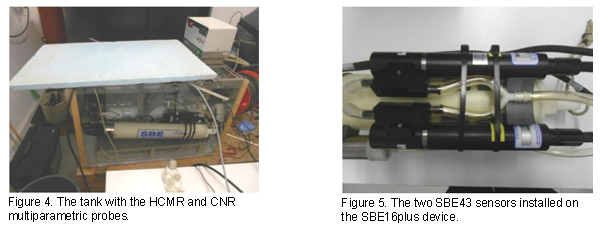November 26th, 2012: JERICO TNA “Calibration and inter-calibration exercise of biogeochemical sensors

The third JERICO TNA experiment (www.jericofp7. eu) started on Monday November 26th, 2012, with the setup of the instrumentation in the POSEIDON Calibration Laboratory of the Hellenic Center for Marine Research in Heraklion (Crete, Greece).
The experiment was part of a research proposed by CNR to the First TNA call of JERICO.
The main purpose of the experiment was to perform a calibration and an inter-calibration activity of bio-geochemical sensors to be operationally and routinely deployed on offshore marine observatories making part on a continuous basis of the marine monitoring network of the Mediterranean Sea.
The main relapse of this activity has been consisted in an important enhancement of the accuracy of the insitu observations on a long term basis of dissolved oxygen, chlorophyll-a and turbidity in the Ligurian basin (Figure 1) collected by a multiparametric probe installed on the W1-M3A off-shore observing system (Figure 2, 3).
The W1-M3A off-shore observing system is moored in the Ligurian-Provencal basin that, for its role in the climate and in the circulation of the Mediterranean region, has been object of intense scientific investigation since the sixties. During winter, processes of dense water formation often occur; strong airsea interaction processes greatly affect both atmospheric and marine circulation, determining a strong variability in the upper ocean thermocline; its productivity is very high and its ecosystem very rich and complex. The Ligurian Sea is characterised by a permanent basin-wide cyclonic circulation involving both surface and intermediate waters. More specifically, the waters flowing northwards on both sides of Corsica, theWestern Corsica Current (WCC) and the Tyrrhenian Current (TC), join along the eastern periphery of the basin and form the Ligurian-Provencal Current (LPC), which flows westward along the coast of Provence, completing the cyclonic loop.

It is important to characterize such water masses not only in terms of their physical properties (temperature and salinity) but also for their bio-geochemical properties. However, long term in-situ monitoring of bio-geo-chemical properties of the ocean is challenging, not only due to marine environmental condition that often are consistent with remote sites, corrosion issues and biologically active basins, but also due to the instruments accuracy and precision needed to obtain useful data for processes analysis as well as for assimilation into models. Indeed, the complexity of the ocean seawater comprehensive of several chemical compounds makes difficult to use measurement techniques very common in laboratory.
Nonetheless, the growing interest in the knowledge of ocean interiortogether with the increasing sophistication of autonomous analyzers promote the investigation of processes such as oxygen consumption, primary productivity and ocean acidity that have not been possible to be autonomously measured in the past.
Apart from their undoubted scientific relevance (for process analysis as well as for modeling requirements) some biogeochemical variables can be nowadays measured through non-intrusive and automatic, partially miniaturized, low-power, in-situ sensors. The variability of these processes due to geographical position, seasonal behaviour and concentrations, that sometimes are very low, requires a close attention to the maintenance procedures of the used instrumentation, especially in terms of calibration.
The performed experiment allowed to obtain an extremely accurate laboratory calibration and a test at sea for oxygen and fluorescence sensors. The calibration for the oxygen probes has been carried out in a tank (Figure 4) furnished by an immersion circulator and two aerators. Two SBE43 oxygen sensors were tested together (Figure 5) and Winkler chemical titration served as the reference standard for evaluating performance characteristics.

Five calibration points (at 14°C, 17.7 °C, and 20.2 °C) had been chosen and three samples for each point have been used for the Winkler analysis. During the one day cruise onboard the R/V Philia three water samples were acquired for the evaluation of both oxygen and chl-a parameters. The results showed an underestimation of oxygen probes with respect to the Winkler samples with an average difference of about 0.43 ml/l for the laboratory test and 0.49 ml/l for the samples taken at sea (Figure 6).

The chl-a calibration were performed by means of two reference concentrations of chlorella culture and eight concentration points of uranine solution in laboratory and with water samples at sea. The results showed a good agreement between tests in laboratory and in field and allowed to calculate a new scale factor for the analyzed sensors (Figure 7) that best fit with the in-situ species present in the Mediterranean waters.

The SBE16plus multiparametric CTD with the freshly calibrated sensors will be installed on the W1-M3A observatory in early spring 2013. This will allow to validate the work done in the laboratory. Near real-time data will be shown in the website of the observatory.
- by Roberto Bozzano(1), George Petihakis(2), Sara Pensieri(1), Tatiana Tsagaraki(2), Manolis Ntoumas(2), Dimitris Podaras(2)
- National Research Council of Italy, Genoa, Italy.
- Hellenic Center for Marine Research, Heraklion, Crete, Greece.
